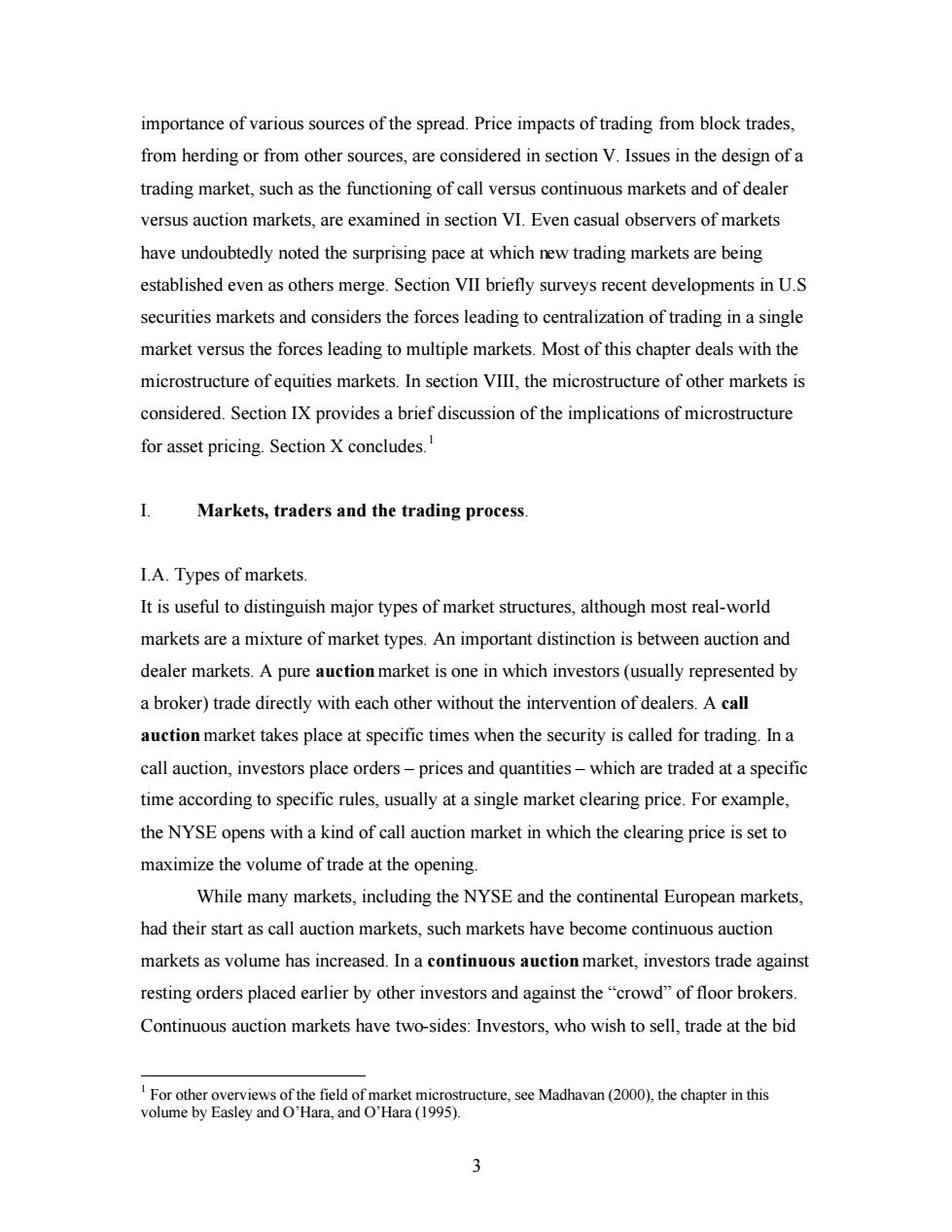正在加载图片...

importance of various sources of the spread.Price impacts of trading from block trades, from herding or from other sources,are considered in section V.Issues in the design of a trading market,such as the functioning of call versus continuous markets and of dealer versus auction markets,are examined in section VI.Even casual observers of markets have undoubtedly noted the surprising pace at which new trading markets are being established even as others merge.Section VII briefly surveys recent developments in U.S securities markets and considers the forces leading to centralization of trading in a single market versus the forces leading to multiple markets.Most of this chapter deals with the microstructure of equities markets.In section VIll,the microstructure of other markets is considered.Section IX provides a brief discussion of the implications of microstructure for asset pricing.Section X concludes. Markets,traders and the trading process. I.A.Types of markets. It is useful to distinguish major types of market structures,although most real-world markets are a mixture of market types.An important distinction is between auction and dealer markets.A pure auction market is one in which investors(usually represented by a broker)trade directly with each other without the intervention of dealers.A call auction market takes place at specific times when the security is called for trading.In a call auction,investors place orders-prices and quantities-which are traded at a specific time according to specific rules,usually at a single market clearing price.For example, the NYSE opens with a kind of call auction market in which the clearing price is set to maximize the volume of trade at the opening. While many markets,including the NYSE and the continental European markets, had their start as call auction markets,such markets have become continuous auction markets as volume has increased.In a continuous auction market,investors trade against resting orders placed earlier by other investors and against the "crowd"of floor brokers. Continuous auction markets have two-sides:Investors,who wish to sell,trade at the bid For other overviews of the field of market microstructure,see Madhavan(2000),the chapter in this volume by Easley and O'Hara,and O'Hara(1995).3 importance of various sources of the spread. Price impacts of trading from block trades, from herding or from other sources, are considered in section V. Issues in the design of a trading market, such as the functioning of call versus continuous markets and of dealer versus auction markets, are examined in section VI. Even casual observers of markets have undoubtedly noted the surprising pace at which new trading markets are being established even as others merge. Section VII briefly surveys recent developments in U.S securities markets and considers the forces leading to centralization of trading in a single market versus the forces leading to multiple markets. Most of this chapter deals with the microstructure of equities markets. In section VIII, the microstructure of other markets is considered. Section IX provides a brief discussion of the implications of microstructure for asset pricing. Section X concludes.1 I. Markets, traders and the trading process. I.A. Types of markets. It is useful to distinguish major types of market structures, although most real-world markets are a mixture of market types. An important distinction is between auction and dealer markets. A pure auction market is one in which investors (usually represented by a broker) trade directly with each other without the intervention of dealers. A call auction market takes place at specific times when the security is called for trading. In a call auction, investors place orders – prices and quantities – which are traded at a specific time according to specific rules, usually at a single market clearing price. For example, the NYSE opens with a kind of call auction market in which the clearing price is set to maximize the volume of trade at the opening. While many markets, including the NYSE and the continental European markets, had their start as call auction markets, such markets have become continuous auction markets as volume has increased. In a continuous auction market, investors trade against resting orders placed earlier by other investors and against the “crowd” of floor brokers. Continuous auction markets have two-sides: Investors, who wish to sell, trade at the bid 1 For other overviews of the field of market microstructure, see Madhavan (2000), the chapter in this volume by Easley and O’Hara, and O’Hara (1995)